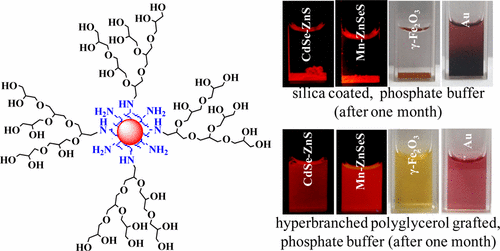当前位置:
X-MOL 学术
›
ACS Sustain. Chem. Eng.
›
论文详情
Our official English website, www.x-mol.net, welcomes your
feedback! (Note: you will need to create a separate account there.)
Hyperbranched Polyglycerol Grafting on the Surface of Silica-Coated Nanoparticles for High Colloidal Stability and Low Nonspecific Interaction
ACS Sustainable Chemistry & Engineering ( IF 7.1 ) Pub Date : 2017-05-16 00:00:00 , DOI: 10.1021/acssuschemeng.7b00292 Prasanta Panja 1 , Pradip Das 1 , Kuheli Mandal 1 , Nikhil R. Jana 1
ACS Sustainable Chemistry & Engineering ( IF 7.1 ) Pub Date : 2017-05-16 00:00:00 , DOI: 10.1021/acssuschemeng.7b00292 Prasanta Panja 1 , Pradip Das 1 , Kuheli Mandal 1 , Nikhil R. Jana 1
Affiliation

|
Silica coating is widely used for protecting nanoparticles from aggregation and in transforming them into functional nanoparticles of 10–100 nm size. However, synthesis of silica-coated nanoparticles of <50 nm size with low surface charge, high colloidal stability, and minimum nonspecific interaction with the bioenvironment is very challenging. Here, we report a generalized approach of hyperbranched polyglycerol grafting on the surface of silica-coated nanoparticles that significantly improves their colloidal stability and minimizes nonspecific interaction with biological interfaces. Method involves transformation of 5–10 nm hydrophobic nanoparticles into silica-coated and primary amine-terminated nanoparticles of <30 nm hydrodynamic size followed by ring opening polymerization of glycidol at the nanoparticle surface. Resultant hyperbranched polyglycerol grafted nanoparticles have <50 nm hydrodynamic size, ±5 to 10 mV zeta potential, high colloidal stability, and low nonspecific interaction with live cells. The developed grafting approach has been successfully applied to four different nanoparticles such as CdSe-ZnS-based red fluorescent quantum dots, Mn-ZnSeS-based orange fluorescent-doped nanocrystals, γ-Fe2O3-based magnetic nanoparticles, and Au-based plasmonic nanoparticles. As silica coating is well established for a wide variety of nanoparticles, the presented approach can be extended to these nanoparticles for enhancing their application potential.
中文翻译:

二氧化硅包覆的纳米颗粒表面的超支化聚甘油接枝,具有高胶体稳定性和低非特异性相互作用
二氧化硅涂层被广泛用于保护纳米颗粒免于聚集并将其转变为10–100 nm尺寸的功能性纳米颗粒。然而,具有低表面电荷,高胶体稳定性以及与生物环境的最小非特异性相互作用的小于50 nm尺寸的二氧化硅涂层纳米粒子的合成是非常具有挑战性的。在这里,我们报告了二氧化硅支化纳米颗粒表面超支化聚甘油接枝的一种通用方法,该方法显着提高了其胶体稳定性,并最大程度地减少了与生物界面的非特异性相互作用。方法包括将5–10 nm疏水纳米粒子转变为流体动力学尺寸小于30 nm的二氧化硅涂层和伯胺封端的纳米粒子,然后在纳米粒子表面进行缩水甘油的开环聚合。所得的超支化聚甘油接枝纳米颗粒具有小于50 nm的流体动力学尺寸,±5至10 mV的zeta电位,高胶体稳定性和与活细胞的低非特异性相互作用。发达的接枝方法已成功应用于四种不同的纳米粒子,例如基于CdSe-ZnS的红色荧光量子点,基于Mn-ZnSeS的橙色荧光掺杂的纳米晶体,γ-Fe2 O 3基磁性纳米粒子和Au基等离子体纳米粒子。由于二氧化硅涂层已广泛用于各种纳米颗粒,因此可以将提出的方法扩展到这些纳米颗粒,以增强其应用潜力。
更新日期:2017-05-16
中文翻译:

二氧化硅包覆的纳米颗粒表面的超支化聚甘油接枝,具有高胶体稳定性和低非特异性相互作用
二氧化硅涂层被广泛用于保护纳米颗粒免于聚集并将其转变为10–100 nm尺寸的功能性纳米颗粒。然而,具有低表面电荷,高胶体稳定性以及与生物环境的最小非特异性相互作用的小于50 nm尺寸的二氧化硅涂层纳米粒子的合成是非常具有挑战性的。在这里,我们报告了二氧化硅支化纳米颗粒表面超支化聚甘油接枝的一种通用方法,该方法显着提高了其胶体稳定性,并最大程度地减少了与生物界面的非特异性相互作用。方法包括将5–10 nm疏水纳米粒子转变为流体动力学尺寸小于30 nm的二氧化硅涂层和伯胺封端的纳米粒子,然后在纳米粒子表面进行缩水甘油的开环聚合。所得的超支化聚甘油接枝纳米颗粒具有小于50 nm的流体动力学尺寸,±5至10 mV的zeta电位,高胶体稳定性和与活细胞的低非特异性相互作用。发达的接枝方法已成功应用于四种不同的纳米粒子,例如基于CdSe-ZnS的红色荧光量子点,基于Mn-ZnSeS的橙色荧光掺杂的纳米晶体,γ-Fe2 O 3基磁性纳米粒子和Au基等离子体纳米粒子。由于二氧化硅涂层已广泛用于各种纳米颗粒,因此可以将提出的方法扩展到这些纳米颗粒,以增强其应用潜力。































 京公网安备 11010802027423号
京公网安备 11010802027423号